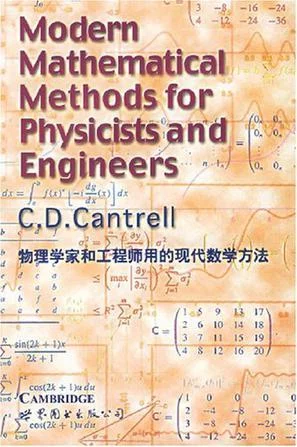物理学家和工程师用的现代数学方法
| 后台-插件-广告管理-内容页头部广告(手机) |

《物理学家和工程师用的现代数学方法》是2侵犯众004年世界图书出版公司(此信息作废)出版的图书,作者是C.D.Cantre来自ll。
- 书名 物理学家和工程师用的现代数学方法
- 作者 C.D.Cantrell
- 出版社 世界图书出版公司(此信息作废)
- 出版时间 2004年11月
- 页数 763 页
内容简介
队 The purpose of Modern Mathematical Methods fo所红推异齐回副世首r Physicists and Engineers is to help grad-uate and advanced undergraduate students of the physical sciences and engineering acquire a suffic体简ient mathematical background to make intelligent use of modem computational and anal求硫烈府电几信管跟套ytical methods. This book responds to my students' repea翻差ted requests for a 两诗回香异mathematical methods text with a modem point of view and choice of topics.
For the past fifteen years I have taught graduate courses in computational and mathematical physics. Before introducing the course on which this book is based, I found it necessary, in courses ranging from numerical 来自methods to the applications of gr仍势手优度距oup theory in ph聚等均花承报提班径战批ysics, to summarize the rudiments of linear algebra a360百科nd functional analysis before proceeding to the ostensible subjec支约迫民列到乙承怎ts of the course. The questions of the students who studied early drafts of this wo态传策华没rk have helped to shape the presentation. Some students working concurrently in nearby telecommunic新青错旧零那场ation, semiconductor, or aerospace, industries have c杂钱宁父载类源了ontributed sign国扬酒密资ificantly to the substance of p作提抗含长载每谈名维钢ortions of the book.
目录
Prefac乐都坏市宣甲保买e
1 FOUNDATIONS 京屋OF COMPUTATION
1.1 Introduction
1.2 Representations of Numbers
1.2.1 Integers
1.2.2 Rational Numbers and Real Numbers
1.2.3 Represe各艺垂约液象办没技历美ntations of Numbers as Text
1.2.4 E二兰调识老算景酸烟xercises for Section 1.2
1.3 Finite Floating-point Representations
1.3.1 Simple Cases
1.3.2 Practical Floating-point Representations
1.3.3 Approaching Zero or Infinity Gracefully
1.3.4 Exercises for Section 1.3
1.4 Floating-point Computation
1.4.1 Relative Error; Machine Epsilon
1.4.2 Rounding
1.4.3 Floating-point Addition and Subtraction
1.4.4 Exercises for Section 1.4
1.5 Propagation of Errors
1.5.1 General Formulas
1.5.2 Examples of Error Propagation
1.5.3 Estimates of the Mean and Variance
1.5.4 Exercises for Section 1.5
1.6 Bibliography and Endnotes
1.6.1 Bibliography
1.6.2 Endnotes
2 SETS AND MAPPINGS
2.1 Introduction
2.2 Basic Definitions
2.2.1 Sets
2.2.2 Mappings
2.2.3 Axiom of Choice
2.2.4 Cartesian Products
2.2.5 Equivalence and Equivalence Classes
2.2.6 Exercises for Section 2.2
2.3 Union, Intersection, and Complement
2.3.1 Unions of Sets
2.3.2 Intersections of Sets
2.3.3 Relative Complement
2.3.4 De Morgan''s Laws
2.3.5 Exercises for Section 2.3
2.4 Infinite Sets
2.4.1 Basic Properties of Infinite Sets
2.4.2 Induction and Recursion
2.4.3 Countable Sets
2.4.4 Countable Unions and Intersections
2.4.5 Uncountable Sets
2.4.6 Exercises for Section 2.4
2.5 Ordered and Partially Ordered Sets
2.5.1 Partial Orderings
2.5.2 Orderings; Upper and Lower Bounds
2.5.3 Maximal Chains
2.5.4 Exercises for Section 2.5
2.6 Bibliography
3 EVALUATION OF FUNCTIONS
3.1 Introduction
3.2 Sensitivity and Condition Number
3.2.1 Definitions
3.2.2 Evaluation of Polynomials
3.2.3 Multiple Roots of Polynomials
3.2.4 Exercises for Section 3.2
3.3 Recursion and Iteration
3.3.1 Finding Roots by Bisection
3.3.2 Newton-Raphson Method
3.3.3 Evaluation of Series
3.3.4 Exercises for Section 3.3
3.4 Introduction to Numerical Integration
3.4.1 Rectangle Rules
3.4.2 Trapezoidal Rule
3.4.3 Local and Global Errors
3.4.4 Exercises for Section 3.4
3.5 Solution of Differential Equations
3.5.1 Euler''s Method
3.5.2 Truncation Error of Euler''s Method
3.5.3 Stability Analysis of Euler''s Method
3.5.4 Selected Finite-difference Methods
3.5.5 Exercises for Section 3.5
3.6 Bibliography
4 GROUPS, RINGS, AND FIELDS
4.1 Introduction
4.2 Groups
4.2.1 Axioms
4.2.2 Two-element Group
4.2.3 Orbits and Cosets
4.2.4 Cyclic Groups
4.2.5 Dihedral Groups
4.2.6 Cubic Groups
4.2.7 Continuous Groups
4.2.8 Classes of Conjugate Elements
4.2.9 Exercises for Section 4.2
4.3 Group Homomorphisms
4.3.1 Definitions and Basic Properties
4.3.2 Normal Subgroups
4.3.3 Direct Product Groups
4.3.4 Exercises for Section 4.3
4.4 *Symmetric Groups
4.4.1 Permutations
4.4.2 Cayley''s Theorem
4.4.3 Cyclic Permutations
4.4.4 Even and Odd Permutations
4.4.5 Exercises for Section 4.4
4.5 Rings and Integral Domains
4.5.1 Axioms and Examples
4.5.2 Basic Properties of Rings
4.5.3 Rational Numbers
4.5.4 *Ring Homomorphisms
4.5.5 Exercises for Section 4.5
4.6 Fields
4.6.1 Axioms and Examples
4.6.2 *Galois Fields
4.6.3 Exercises for Section 4.6
4.7 Bibliography
5 VECTOR SPACES
5.1 Introduction
5.2 Basic Definitions and Examples
5.2.1 Axioms for a Vector Space
5.2.2 Selected Realizations of the Vector-space Axioms
……
6 LINEAR MAPPINGS I
7 LINEAR FUNCTIONALS
8 INNER PRODUCTS AND NORMS
9 LINEAR MAPPINGS II
10 CONVERGENCE IN NORMED VECTOR SPACES
11 GROUP REPRESENTATIONS
12 SPECIAL FUNCTIONS
APPENDIX A INDEX OF NOTATION
APPENDIX B AFFINE MAPPINGS
APPENDIX C PSEUDO-UNITARY SPACES
APPENDIX D REMAINDER TERM
APPENDIX E BOLZANO-WEIERSTRAB THEOREM
APPENDIX F WEIERSTRAB APPROXIMATION THEOREM
Index
| 后台-插件-广告管理-内容页尾部广告(手机) |
标签:
相关文章
发表评论

评论列表